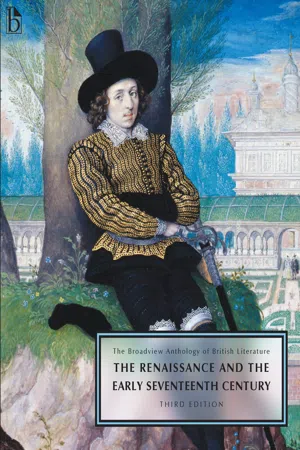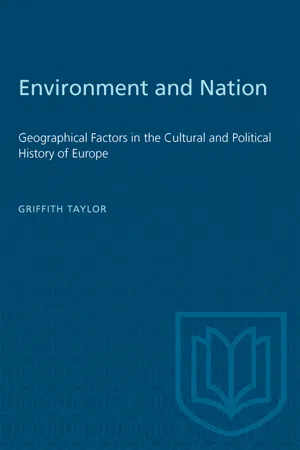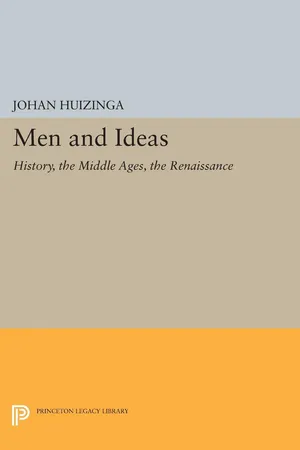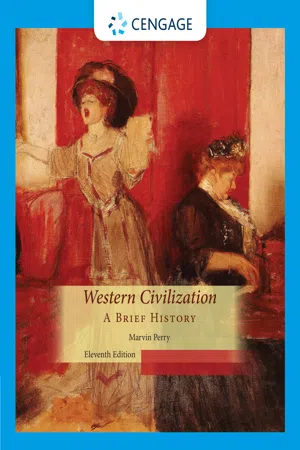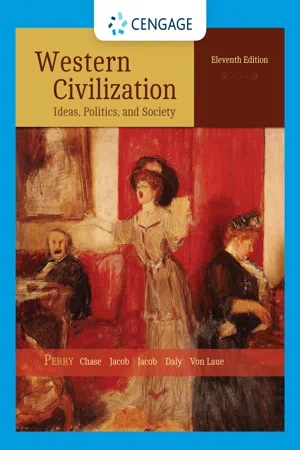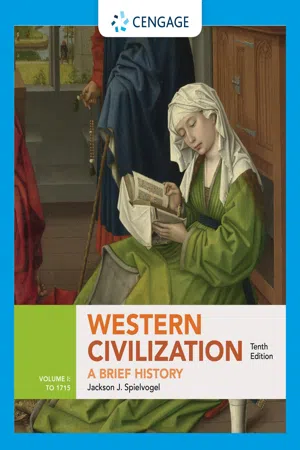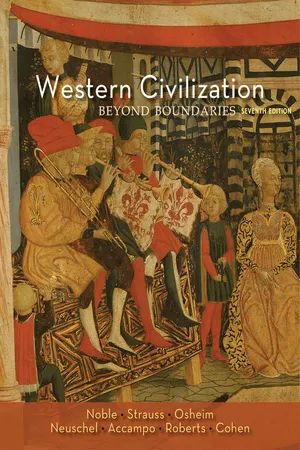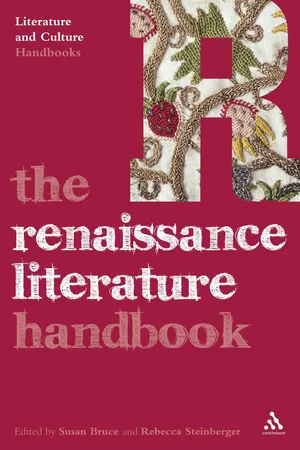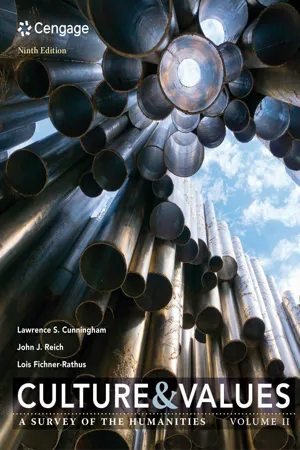History
European Renaissance
The European Renaissance was a period of cultural, artistic, and intellectual rebirth that took place in Europe from the 14th to the 17th century. It marked a transition from the medieval to the modern world and saw a revival of interest in classical learning, humanism, and the arts. The Renaissance had a profound impact on literature, philosophy, science, and the visual arts.
Written by Perlego with AI-assistance
Related key terms
1 of 5
11 Key excerpts on "European Renaissance"
- Joseph Black, Leonard Conolly, Kate Flint, Isobel Grundy, Wendy Lee, Don LePan, Roy Liuzza, Jerome J. McGann, Anne Lake Prescott, Barry V. Qualls, Jason Rudy, Claire Waters(Authors)
- 2016(Publication Date)
- Broadview Press(Publisher)
The Renaissance and the Early Seventeenth Century T he term “Renaissance” has turned out to be a good deal less stable than was once assumed. The word “Rinascenza” (Italian: “rebirth”), from which “Renais-sance” derives, was coined by the Italian historian Giorgio Vasari in 1550 to refer to what Vasari saw as having taken place in Italy over the previous two centu-ries: a rebirth of the ideas and the aesthetic values associated with the classical cultures of ancient Greece and Rome, after a thousand-year-long era in which civilization had gone into eclipse. By the time of Vasari it had already become conventional to think of that thousand-year period as the “Middle Ages” (or, using the Latinized form of the same phrase, the “medieval period”). 1 Subsequently the habit developed of seeing the Renaissance as being followed by another discrete era, the Reformation, a period characterized above all by the challenge presented by Protestantism to the author-ity of the Church of Rome. Recent generations of scholarship have done much to destabilize this conceptual framework. Medievalists have located a variety of “renaissances” in, for example, the ninth and the twelfth centuries, and have thor-oughly debunked the idea that the supposed “dark ages” were lacking intellectual or cultural life.- eBook - PDF
- W.H. Vogel, A. Berke(Authors)
- 2009(Publication Date)
- SPB Academic Publishing(Publisher)
The Renaissance 158 The Renaissance Introduction Historical The period after the early Middle Ages has no defined beginning. Since the 19th century, it has been called the ‘Renaissance’, which means rebirth (rinascere ital.). It is reckoned to have started in late 13th century Florence. The writings of Dante Alighieri (1265– 1321) and Francesco Petrarch (1304–1374) and the paintings of Giotto di Bondone (1267–1337) are considered the germs of this new cultural movement, which extended from the beginning of the 14th century to the middle of the 17th century. For the first two centuries, the Renaissance was an Italian phenomenon, with Italian views dominating the rest of Europe. Later the Renais-sance spread throughout most of Europe. During that time, Italy and most of the European countries were engaged in internal power struggles as well as wars amongst each other. City states in Italy, such as Milan, Venice, Florence, Rome and Naples, and small dukedoms and kingdoms in other countries fought bitterly and bloodily with each other, as indi-vidual rulers and nobles strove for territory and power. At one time The Holy Roman Empire included Italy, Germany and Aus-tria, but its emperors soon lost power, since the individual nobles, dukes and kings became more powerful. In France, the French found themselves engaged in the ‘hundred year’ war with Eng-land (which actually lasted from 1337–1453) and the dukes of Burgundy and later the house of Bourbon rose to power. In Eng-land, the different lineages of the royal family fought each other, leading eventually to the War of the Roses (1455–1485). In addi-tion, England was in constant conflict with Scotland and Ireland. On the Iberian Peninsula, the power of the Muslim regime was finally broken in the 15th century and Spain and Portugal became the dominant powers. - eBook - PDF
Environment and Nation
Geographical Factors in the Cultural and Political History of Europe
- Griffith Taylor(Author)
- 2019(Publication Date)
- University of Toronto Press(Publisher)
CHAPTER XI THE RENAISSANCE IN TIME AND SPACE A. The Development and Spread of the Universities It is hardly possible to define in a few words what is meant by the Renaissance. It involved a period of time marked by a rapid evolu-tion of culture-but the time and the character of the culture differed considerably from place to place. It is this latter aspect of the prob-lem-the migration and modification of the Renaissance as it pro-gressed-which makes the geographical treatment of considerable interest. Throughout much of its development it is closely linked with Humanism and with the Reformation. It would be foolish, however, to look upon it as a factor in national differentiation of the same importance as language or religion . It was rather a phase in human progress which was largely-though not wholly-confined to the Western half of Europe; at any rate in the earlier, more significant stages of the Renaissance. Yet its roots are to be found in the South-east-and a later phase of its flowering is to be perceived in the North-east. In the present brief survey of the Renaissance, our attention will be confined mainly to two phases, first, the growth of a more liberal and modern frame of mind, which is labelled Humanism, and, secondly, the progress in the Arts will be illustrated by the develop-ment of architecture. Both subjects illustrate very clearly that shift of the area of notable social evolution from the Southeast to the West which marked the close of Medieval Times. It has already been stated that it is difficult to date the beginning or end of the Renaissance. Still there are considerable differences in its stages of development and it will be found helpful to consider these for a moment before discussing them separately. The following four periods seem to be fairly well-defined, at any rate in the areas including Italy, France, England and Germany. They are illustrated in the four maps (Figs. 48 to 51). - eBook - PDF
Men and Ideas
History, the Middle Ages, the Renaissance
- Johan Huizinga(Author)
- 2014(Publication Date)
- Princeton University Press(Publisher)
The Renaissance came because people learned how to understand the spirit of the ancients, and its essential element was the imitation of classical art and literature. Some of the textbooks also made a small place for the art of printing and the discovery of America among the causes of the general revival. I am not sure which schoolbook it was whose chapters on the modern period are said to have begun with the confident opening sentence 'The rebirth of the human spirit dates from the discovery of firearms," a sentence that, well considered, is Marxism a outrance. But be that as it may, the opinion then current, that the imitation of antiquity was the alpha and omega of the Ren- aissance, has never been more than a secondhand simplification of the views of those whose minds cherished the concept of the Renaissance and brought it to maturity. Even Voltaire, we have seen, had a much broader view of the phenomenon of revival. If any one person must be made responsible for the school opinion, it would have to be Pierre Bayle. Now we have come to the full unfolding, beneath the hand of Jacob Burckhardt, of the concept of the Renaissance in all its rich, colorful aspects as a form of life far transcending the limits of historical study for its own sake. It is a fact that the great Swiss scholar was inspired by a The Problem of the Renaissance 255 seer whose hallucinated vision illuminated history as if with flashes of lightning: Jules Michelet. The year 1855 saw the appearance of Michelet's Histoire de France au XVIiime siicle, the seventh volume of his Histoire de France, with the subtitle Renaissance. Michelet's attitude toward the great cultural transformation was that of the Enlightenment, as it had merged into liberalism and was reflected in his brilliant mind. What the sixteenth century had brought was, to him just as much as to the rationalists of the eighteenth century, light—light in the barbaric darkness of the Middle Ages. - eBook - PDF
- Marvin Perry(Author)
- 2015(Publication Date)
- Cengage Learning EMEA(Publisher)
Renaissance humanism exuded a deep confidence in the capacities of able people, instructed in the wisdom of the ancients, to understand and change the world. This new confidence was closely related to another distinctive feature of the Renaissance: the cult of the individual. Both prince and painter were motivated in part by the desire to display their talents and to satisfy their ambitions. This individual striving was rewarded and encour-aged by the larger society of rich patrons and calculating princes, which valued ability. Gone was the medieval Christian emphasis on the vir-tue of self-denial and the sin of pride. Instead, the Renaissance placed the highest value on self- expression and self-fulfillment—on the realiza-tion of individual potential, especially of the gifted few. The Renaissance fostered an atmo-sphere in which talent, even genius, was allowed to flourish. To be sure, the Renaissance image of the in-dividual and the world, bold and novel, was the exclusive prerogative of a small, well-educated urban elite and did not reach down to include the masses. Nevertheless, the Renaissance set an example of what people might achieve in art and architecture, taste and refinement, edu-cation and urban culture. In many fields, the Renaissance set the cultural standards of the modern age. B ACKGROUND TO THE R EFORMATION : T HE M EDIEVAL C HURCH IN C RISIS The Renaissance had revitalized European intel-lectual life and in the process discarded the me-dieval preoccupation with theology. Similarly, the Reformation marked the beginning of a new religious outlook. The Protestant Reformation, however, did not originate in the elite circles of humanistic scholars. Rather, it was sparked by Martin Luther (1483–1546), an obscure German monk and brilliant theologian. Luther started a rebellion against the church’s authority that in less than one decade shattered the religious unity of Christendom. - eBook - PDF
Western Civilization
Ideas, Politics, and Society
- Marvin Perry, Myrna Chase, James Jacob, Margaret Jacob, Marvin Perry, Myrna Chase, James Jacob, Margaret Jacob(Authors)
- 2015(Publication Date)
- Cengage Learning EMEA(Publisher)
The revival itself was done too self-consciously for that. In the very act of looking back, the hu-manists differentiated themselves from the past and recognized that they were different. They were in this sense the first modern historians because they could study and appreciate the past for its own sake and, to some degree, on its own terms. A Word of Caution We have emphasized in this chapter that the Renais-sance, especially in Italy, represented a sharp and deliberate break with medieval tradition. Thinkers crawled out from under that tradition and adopted striking new views in many fields, as, for instance, in art and science, philosophy and religion, politics and education. The result was the beginnings of a new kind of high culture, less religious and more secular, with more emphasis on individualism, ar-tistic creativity, and political realism. The starting point for this development was to a large degree a rediscovery of the classics, that is, the writings of ancient Greek and Roman thinkers. These works were taught and translated as never before since the fall of the Roman Empire and the onset of the so-called Dark Ages a thousand years before. In other words, educated Europeans laid the founda-tions for a new Renaissance culture by reviving a once-powerful, dead culture and being inspired and instructed by it. Renaissance men and women undertook this project and saw it through more or less on their own initiative and without help from the outside. The Renaissance, in this view, was largely a European affair and the achievement of the northern Italian city-states in the first instance. - eBook - PDF
Western Civilization
A Brief History, Volume I: to 1715
- Jackson Spielvogel(Author)
- 2019(Publication Date)
- Cengage Learning EMEA(Publisher)
Chapter Outline and Focus Questions 12-1 Meaning and Characteristics of the Italian Renaissance Q What characteristics distinguish the Renaissance from the Middle Ages? 12-2 The Making of Renaissance Society Q What major social changes occurred during the Renaissance? 12-3 The Italian States in the Renaissance Q How did Machiavelli’s works reflect the political realities of Renaissance Italy? 12-4 The Intellectual Renaissance in Italy Q What was humanism, and what effect did it have on philosophy, education, and attitudes toward politics? 12-5 The Artistic Renaissance Q What were the chief characteristics of Renaissance art, and how did they differ in Italy and northern Europe? 12-6 The European State in the Renaissance Q Why do historians sometimes refer to the monarchies of the late fifteenth century as “new monarchies” or “Renaissance states”? 12-7 The Church in the Renaissance Q What were the policies of the Renaissance popes, and what impact did those policies have on the Roman Catholic Church? WERE THE FOURTEENTH AND FIFTEENTH CENTURIES a continuation of the Middle Ages or the beginning of a new era? Both positions can be defended. Although the disintegrative patterns of the fourteenth century continued into the fifteenth, at the same time there were elements of recovery that made the fifteenth century a period of significant political, economic, artistic, and intellectual change. The humanists or intellectuals of the age considered their period (from the mid-fourteenth to the mid-sixteenth century) an age of rebirth, believing that they had restored arts and letters to their former glory after they had been “neglected” or “dead” for centuries. The human-ists also saw their age as one of accomplished indi-viduals who dominated the landscape of their time. Michelangelo, the great Italian artist of the early sixteenth century, and Pope Julius II, the “warrior pope,” were two such titans. - eBook - PDF
Western Civilization
Beyond Boundaries
- Thomas F. X. Noble, Barry Strauss, Duane Osheim, Kristen Neuschel(Authors)
- 2013(Publication Date)
- Cengage Learning EMEA(Publisher)
Due to electronic rights, some third party content may be suppressed from the eBook and/or eChapter(s). Editorial review has deemed that any suppressed content does not materially affect the overall learning experience. Cengage Learning reserves the right to remove additional content at any time if subsequent rights restrictions require it. 356 Chapter 12 The Renaissance Chapter Summary ◆ ◆ How did Italians use classical values to deal with cultural and political issues? The Renaissance was a broad cultural movement that began in Italy in response to a series of crises in the early fourteenth century. It was a cultural and ideological movement based on the assumption that study and imitation of the past was the best method for reform and innovation in the future. The impulse for change arose from the belief, shared by thinkers from Petrarch to Machiavelli, that a great deal could be learned from study of the Roman past. This was the basis for humanistic innovations in language, history, and politics. Even revolutionary thinkers, such as Lorenzo Valla and Niccolò Machiavelli, began with the study of classical literature and history. ◆ ◆ What was “new” about Renaissance art? The same transformation is evident among the artists. Early in the fifteenth century, Florentines who experimented with perspective were intent on recovering lost Roman knowl- edge, and Michelangelo was praised not only for mastering but also for surpassing Roman norms. The artistic innovations of Italy were noted and valued throughout the Mediterranean and northern Europe. Artists like Albrecht Dürer combined their understanding of Italian art with northern ideas. Throughout Europe, art was an important component of religious and political culture. ◆ ◆ In what ways did humanism outside Italy differ from Italian humanism? Humanistic studies outside of Italy were less tied to public life. - eBook - PDF
- Susan Bruce, Rebecca Steinberger, Susan Bruce, Rebecca Steinberger(Authors)
- 2009(Publication Date)
- Continuum(Publisher)
The rediscovery or ‘rebirth’ (‘re-naissance’) of knowledge about Greek and Latin artistic production gives the age its traditional name, as scholars and artists in Italy, and later across Europe, were reshaped by their experiences with classical life, and moved aggressively to reshape their native traditions. In Italy this provoked a revolution in the visual arts, so that the views of a classical thinker like Pythagoras, with his maxim that ‘man is the measure of all things’, can be seen to be echoed in the celebration of human beauty visible in the paintings of Fra Angelico, Botticelli, Leonardo da Vinci and Michelangelo. In England, classical learning inspired a new approach to lan-guage: a revised school curriculum based on Latin education was developed, and a number of grammar schools founded (especially during the short reign of King Edward VI), many of which still exist today. More generally, the age saw the birth of a reading culture that often invoked the values of the classical world. This movement was as much about making language heroic – and beautiful – as it was about particular texts or authors; art historian E. H. Gombrich wryly claims that the Renaissance came ‘not so much from the discovery of Man as in the discovery of diphthongs’ (Fraser 1967). This new approach to learning that characterized the intellectual movement was known as humanism. This is a term that has meant very different things across the centuries. Renaissance humanism was something quite different from the secular humanism of the twenty-first century, being originated by very pious Christian men. What defined it were certain emphases, especially a specific approach to language, to beauty, to civic life and to the potential of the individual. - eBook - PDF
Living on the Edge in Leonardo’s Florence
Selected Essays
- Gene Brucker(Author)
- 2005(Publication Date)
- University of California Press(Publisher)
The discovery of ancient scientific texts, either lost or known only in fragments, by Euclid, Archimedes, Galen, Pliny, and Ptolemy, contributed to the investigations and speculations that led ultimately to the revolutionary works of Copernicus, Vesalius, and Galileo. In yet an- The Italian Renaissance / 13 other realm, that of religion, the influence of Renaissance humanism has been shown recently to be much greater than Burckhardt allowed. Scholars have pointed to the strong affinities between the Renaissance and the Reformation, both backward-looking movements: the one to antiquity, the other to the early centuries of the church. They have em- phasized, too, the focus by reformers and humanists as the source of di- vine revelation in one case, and of human wisdom in the other. They have also noted the epistemological affinities between humanists and Protestant theologians, both of whom “distinguished between realms, between ultimate truths altogether inaccessible to man’s intellect, and the knowledge that men needed to get along in this world, which turned out to be sufficient for his purposes.” 19 MATURITY AND DECLINE Historians are in general agreement that the fifteenth century repre- sented the mature phase, the apogee, of Italian Renaissance culture. After the crisis conditions of the late fourteenth century, the peninsula experienced a gradual recovery of its population and its economy, most notably in the decades after 1450. Italian politics became somewhat less chaotic, with the gradual formation of five powerful regional states: the republics of Venice and Florence, the signorial regime in Milan, the kingdom of Naples, and the Papal States. With varying degrees of suc- cess, each of these regimes developed larger and more intrusive bureau- cracies, more exploitative fiscal systems, and more rational military structures. In 1454, these states formed a league which brought a lim- ited measure of stability to Italian politics. - eBook - PDF
Culture and Values
A Survey of the Humanities, Volume II
- Lawrence Cunningham, John Reich, Lois Fichner-Rathus, , Lawrence Cunningham, John Reich, Lois Fichner-Rathus(Authors)
- 2017(Publication Date)
- Cengage Learning EMEA(Publisher)
Copyright 2018 Cengage Learning. All Rights Reserved. May not be copied, scanned, or duplicated, in whole or in part. Due to electronic rights, some third party content may be suppressed from the eBook and/or eChapter(s). Editorial review has deemed that any suppressed content does not materially affect the overall learning experience. Cengage Learning reserves the right to remove additional content at any time if subsequent rights restrictions require it. 478 | CHAPTER 14 The High Renaissance in Northern Europe and Spain otherworldly nature of the upper canvas. The emotion is high pitched and exaggerated by the tumultuous atmosphere. This emphasis on emotionalism links El Greco to the onset of the Baroque era. His work contains a dramatic, the- atrical flair, one of the hallmarks of the 17th century. musIc As in the visual arts, the Renaissance produced major stylistic changes in the development of music, but in general, musical development in the Renaissance was marked by a less severe break with medieval custom than was the case with the visual arts. Although 16th-century European composers began to increase the complexity of their style, frequently using polyph- ony, they continued to use forms developed in the High Middle Ages and the Early Renaissance. In religious music, the motet remained popular, set to a religious text. Com- posers also continued to write madrigals (songs for three or more solo voices based generally on secu- lar poems). For the most part, these were intended for performance at home, and elaborate, interweav- ing polyphonic lines often tested the skill of the singers. The difficulty of the parts often made it necessary for the singers to be accompanied instrumentally. This increasing complex- ity produced a significant change in the character of madrigals, which were especially popular in Elizabethan England. None- theless, 16th-century musicians were recognizably the heirs of their 13th- and 14th-century predecessors.
Index pages curate the most relevant extracts from our library of academic textbooks. They’ve been created using an in-house natural language model (NLM), each adding context and meaning to key research topics.
